Every seller’s goal on Amazon is to make as many sales as possible. There are so many factors that influence a customer to purchase your product: where your products rank among keyword search results, your review count and rating, whether your listing features quality images and informational copy, shipping speed, and of course, your product’s price all figure into the decision to buy.
Having the proper pricing strategy on Amazon for your private label brand is crucial. With the private label method, you’re not competing for the Buy Box as you would using retail arbitrage or wholesale methods, but you are competing with the other products within the search results.
Priced too high, your product may not entice customers—they’ll opt for your competitors’ relative affordability. Price your product too low, and you may start a pricing war with your competitors—sending both the value of your product niche and your own profitability on a downward spiral.
So, how do you choose the perfect price for your product? There’s no one-size-fits-all strategy—the right price largely comes down to your product’s quality, your production costs, and what customers are looking for, all of which can vary from your competitors. That said, there are a few data-driven techniques that will help you arrive at the best price for your product.
Pricing products on Amazon in 2021
When researching the right price for your product, it helps to understand the Amazon marketplace, in terms of both what consumers want and how other sellers (your competition) meet those demands.
Ecommerce is surging, and more people are shopping online than ever before. In the past year, more U.S. consumers have shopped on Amazon than any other retail outlet—whether online or in-store. And while Amazon shoppers care about finding products listed at the lowest price, more than three quarters of consumers are willing to spend up to $100 on a single product from Amazon.
That said, consumers aren’t splurging on $100 items each time they shop on Amazon, a fact which is reflected in Amazon sellers’ average prices. In 2021, more than half of the products sold on Amazon are priced between $11 and $25, with another 32% priced over $25.
Furthermore, 57% of highly successful sellers (those who have achieved lifetime profits of $500,000 or more) price their products below $30. You don’t need to sell luxury products to make a fortune as an Amazon seller—you just have to optimize your product pricing strategy.
Here are Jungle Scout’s top methods for pricing Amazon products.
1. Understand your profit margin
Watching revenue roll in is great—but only when it covers the cost of sourcing, listing, and shipping your products by a healthy gap. That’s why it’s so important to calculate your profit margin early in the product research phase. Otherwise, you could eventually lose time and money on each sale.
Profit margin is the percentage of income you keep after all expenses, which include cost of goods sold (COGS), Amazon referral fees, FBA fees, PPC costs, and other expenses. In general, profit margin is calculated with the following formula:
Profit Margin = ((Sales – Total Expenses) ÷ Revenue) x 100
We can roughly estimate our profit margin by considering the “Rule of Three.” Assume that the money from each product’s sale will be broken up in the following way: 1⁄3 goes toward fees, 1⁄3 are eaten up by landed costs before it’s even sold (landed costs are what you spend to ship and pay duties, taxes, and fees on your inventory), and 1⁄3 goes to you as profit. Dividing our profit by the product’s price gives us our profit margin.
For example, let’s say you price your product at $30. According to the Rule of Three, you can expect to shell out at least $10 in landed costs ($30 divided by 3), plus another $10 in fees, and you’ll profit at least $10.
To determine your profit margin, divide your $10 profit by the sale price of $30.
$10 ÷ $30 = .33
Finally, multiply by 100 to get a percentage, and you’ve ended up with a profit margin of 33%. Spoiler alert: that’s a great profit margin!
Amazon sellers should aim for a profit margin between 25% and 30% for their private label products. For context, over two thirds (68%) of Amazon sellers operate on profit margins above 10%; over one third have profit margins over 20%. The higher, the better: nearly half of those highly successful sellers mentioned above maintain profit margins between 21-50%.
Achieving a comfortable margin isn’t just great for profitability—it also gives you some built-in wiggle room for your initial advertising spend. Once you’ve optimized your campaigns, these costs should go down—and profits up.
Before sourcing a product from your supplier, you should already have an idea of what you’ll charge for it on Amazon. You need to calculate your landed cost, Amazon fees, inbound shipping fees, storage fees, as well as advertising costs.
Analyze potential products for profitability, demand, and competition, and take all product-related costs into consideration.
Identify your minimum and maximum price
Use your sourcing costs as a reference to calculate your minimum and maximum sales prices. These boundaries will keep your product in competition with similar items.
Remember: if your prices are too high, customers will buy from your competitors. Price your product too low, and you’ll eat your own profits.
To avoid the latter, set your minimum price to your breakeven price—that is, the same amount of money it costs to produce it. Let me show you an example.
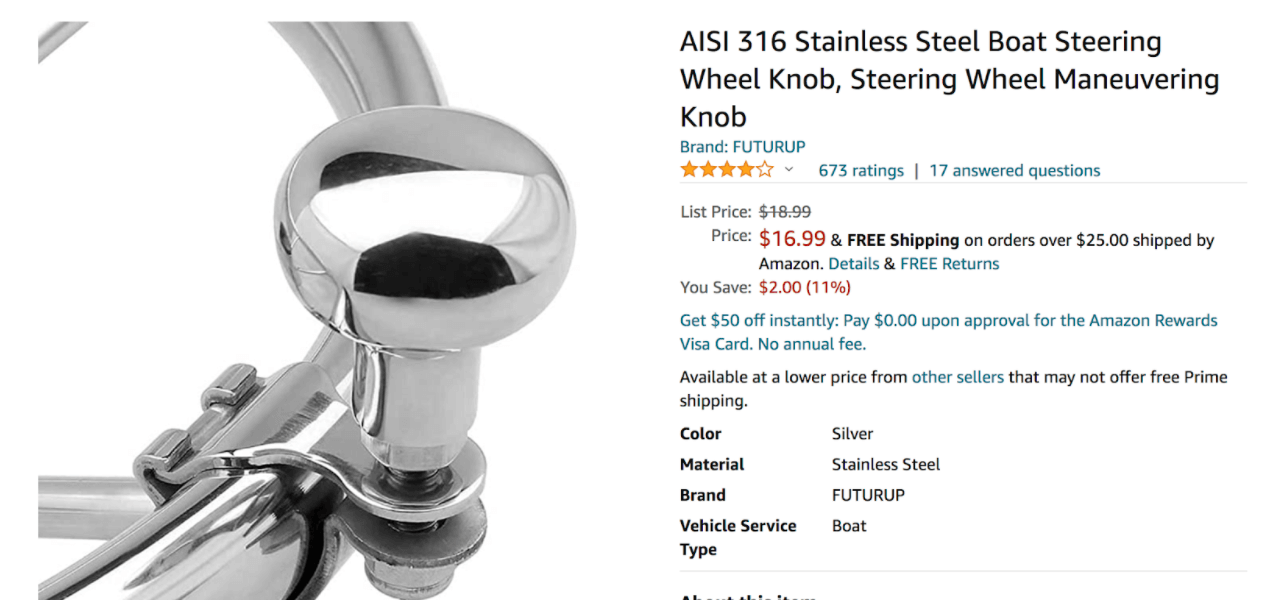
Let’s say I’d like to sell steering wheel knobs for boats. I’ll use the one pictured above for product research. It sells for $16.99. Hypothetically, I can source a similar model from my supplier in China for a total of $4.56 per unit in landed costs.
Next, I’ll determine potential fees. Using Amazon’s FBA Revenue Calculator, I’ll plug in the exact ASIN of my example steering wheel knob to get accurate weight and size measurements, which can affect Amazon fees.
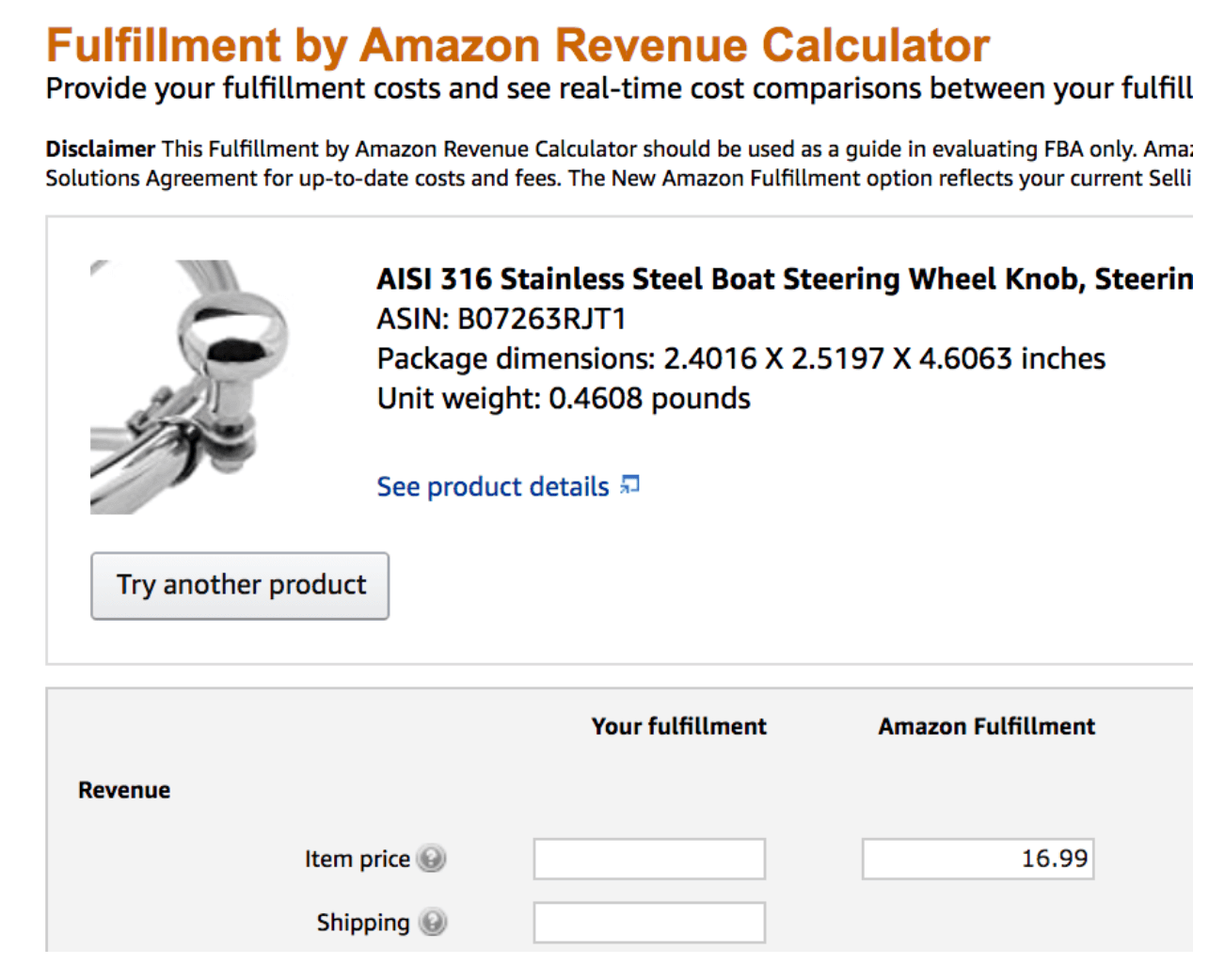
I’ll type in the current price of $16.99 under “Amazon Fulfillment,” since I’m an FBA seller. Then I’ll add in $4.56 for product cost.
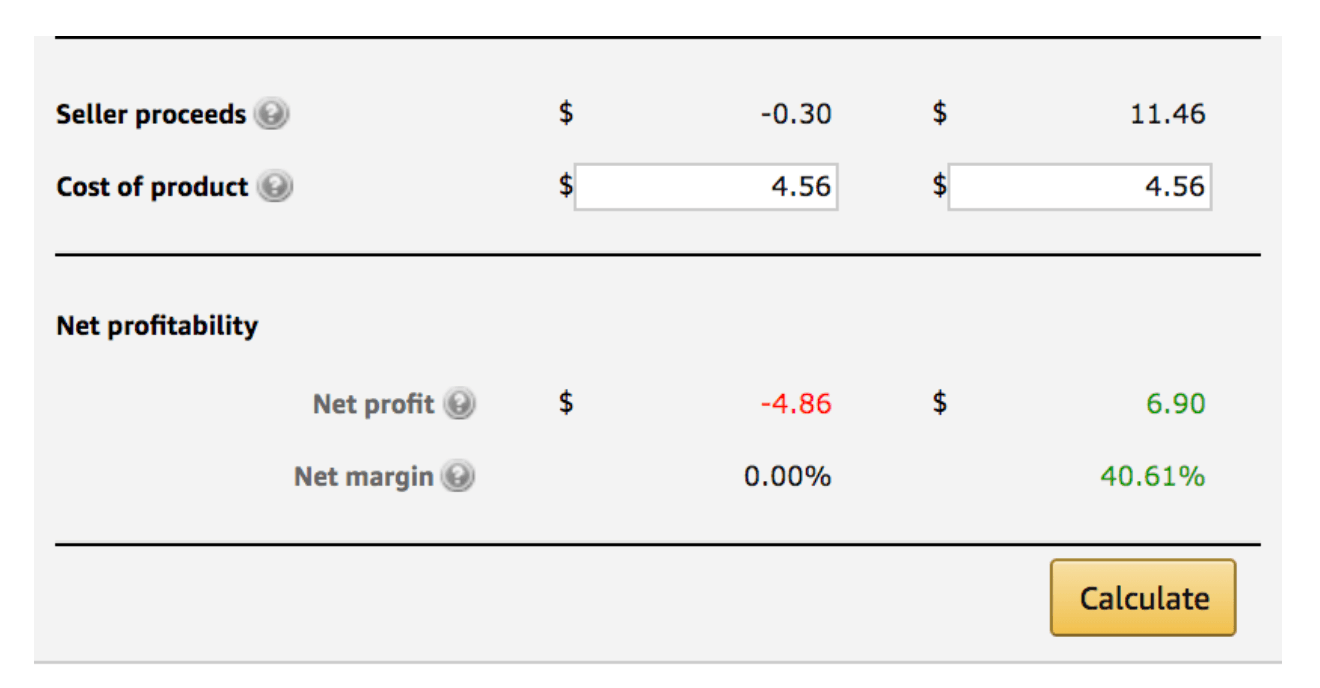
At that price point, our projected profit through FBA would be $6.90 per sale, with a profit margin of nearly 41%. Now let’s figure out what our break even price will be, again using the FBA Revenue Calculator.
In the “Revenue” box in the calculator, play around with different prices until “Net profitability” is $0.00. That’s the breakeven price—the cheapest we could price our product and still cover production costs (which exclude PPC and other advertising costs.)
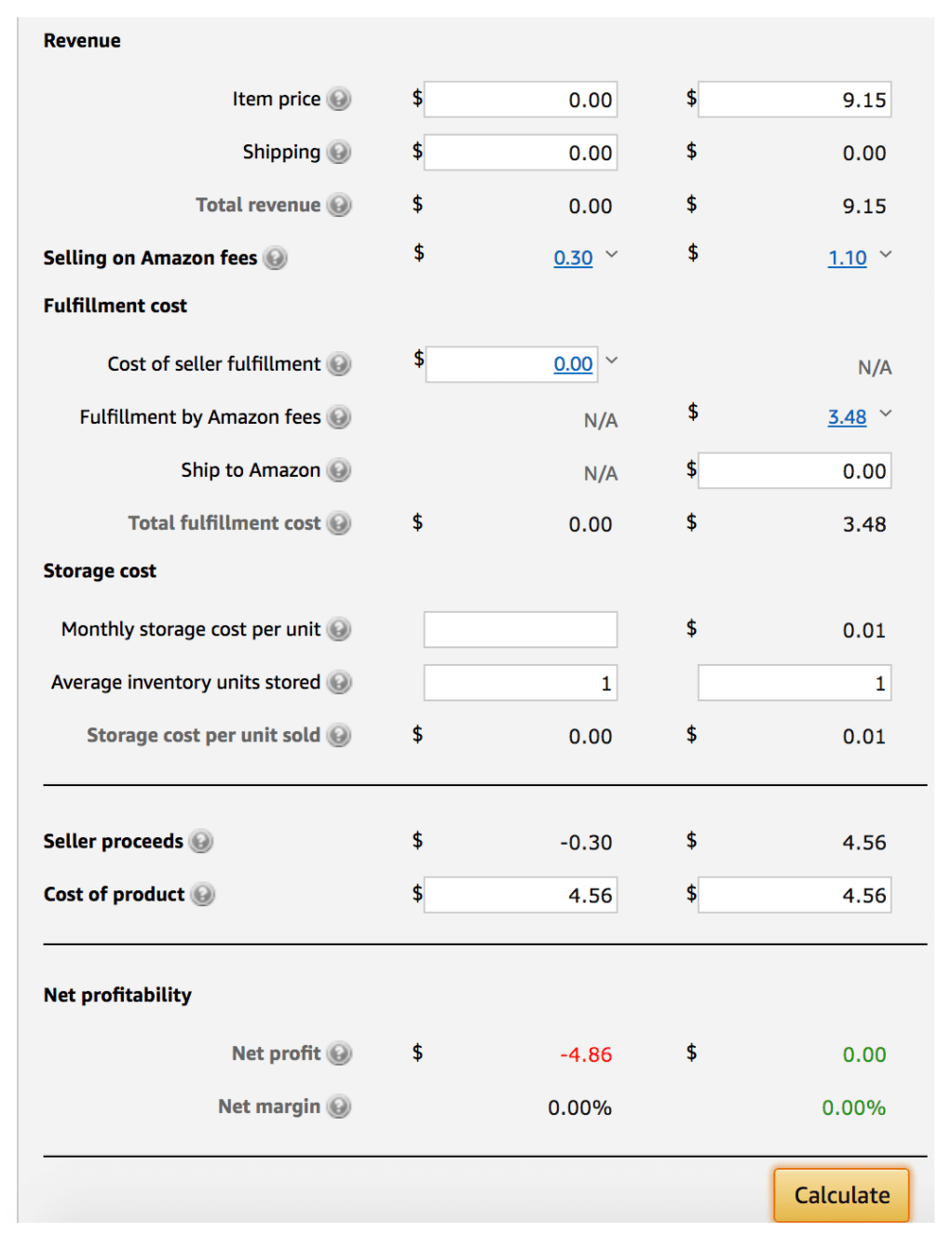
After a little trial and error, I determined that our breakeven price is $9.15. Note that you’d never want to actually sell your product at your breakeven price—you won’t make a profit that way! But knowing your minimum will help you from going too low.
Use the Jungle Scout Extension to view a product’s average sale price. This will give you an idea of what your maximum price should be. If you do want to set your price higher than average, you’ll need to justify the hike—which we’ll discuss in technique #3.
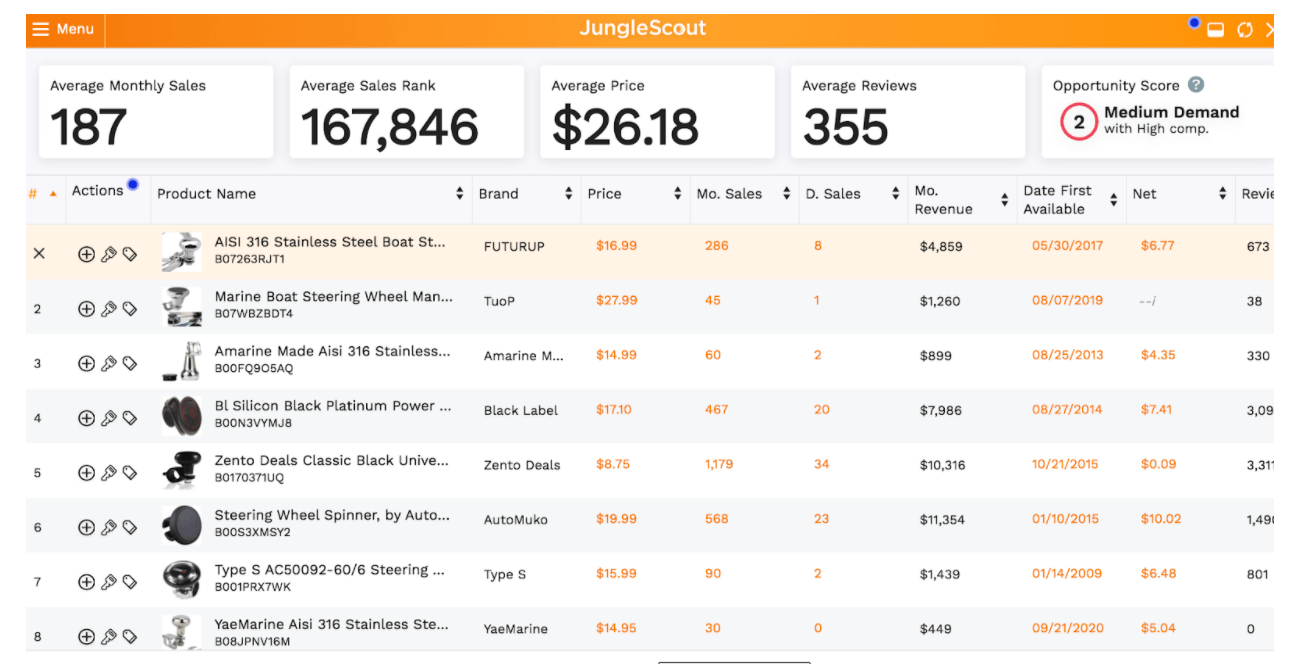
This kind of product has an average price of $26.18. If we look closer, we can see that most are priced below $20, and that the average is skewed high because one of these products sells for $27.99.
If we keep our price around $16, we’ll have a healthy profit margin and we’ll stay competitive with most of our competitors.
2. Price Competitively
As a private label brand on Amazon, your goal should be to provide a great value to the customer. Value comes in the form of high product quality at a reasonable price.
Your goal should be to build a legitimate, unique brand on Amazon versus selling generic products. This creates more perceived value for your product and sets them apart from the competition.
Price new products with no reviews lower at first
If your product is brand new with no reviews, it may be wise to keep your price a dollar or so lower than your lowest-priced competitor. Use this as a short-term strategy until your product begins to gain traction and reviews.
For example, if the average price point for a similar product is $16.99 – $19.99, try pricing your product at the lower end of that range. You can try $15.99 or $16.95. Just be sure to avoid setting a price that’s significantly lower than the competition, as that could trigger a “price war.”
Here’s what I mean by that: let’s say you price your product at $11.99—well below the $16.99 average price for similar products. Your closest competitor notices your low price and decides to undercut you so they don’t lose sales. Soon, customers won’t pay more than $11 for a similar product, and your other competitors have no choice but to also lower their prices indefinitely. It’s a race to 0% profit margins, and nobody wins.
The last thing you want to do is devalue your product or niche—that harms everyone’s profitability.
What happens if my competitors aggressively cut their prices?
Entering a price war is a major concern for private label sellers on Amazon. In fact, two thirds of sellers are concerned about increased competition driving prices down.
Sellers who seek to drive sales through aggressive price-cutting will typically not last long as a seller. They’ll quickly realize that by driving prices down, they’re removing any possible profitability their product had, especially after factoring in PPC costs.
My advice: stand your ground. Don’t play along with “race to the bottom” tactics and destroy the product niche you’re selling in. Eventually, those sellers will be phased out when they lose profitability. Stay within your minimum and maximum price and focus on creating a great, optimized listing.
Monitor your competitor’s price
That said, you’ll want to keep an eye on how your competitors price similar products. Whether you are just starting out doing product research or expanding your current product line, it is important to track your competitors’ products over time to determine the product’s viability.
Use Product Tracker to track real-time sales, Best Seller Rank, inventory, and Buy Box price. You want to be sure that your competitors’ products are actually selling at a consistent price point, and that you’re not inadvertently entering a price war.
What price point should I stay in?
We know that as a new seller, you’ll likely have a smaller budget to work with—and that’s ok! But this may limit you in terms of what you can sell. For instance, if you have a small startup budget of $500 to $1,000, you won’t be able to sell products with a $100 price point, as you won’t be able to meet your supplier’s minimum order quantity.
Not to worry—most sellers list affordably-priced products and are still successful. Here are the most common product price points, according to Amazon sellers:
Price point
Percent of Sellers
Under $5
3%
$6-10
6%
$11-15
15%
$16-20
20%
$21-25
16%
$26-30
14%
$31-50
8%
$51-100
5%
$101+
4%
N/A – My product prices vary significantly.
8%
As you can see, as prices rise, competition decreases. That’s partly because listing expensive products requires more investment into inventory.
If you have the budget, go for a higher-priced product to reduce the risk of a price war among lower-priced products.
3. Differentiate your product
To justify setting a higher price than your competitors, you need to show customers why your product is worth more than a similar item.
You can’t just source a competitor’s exact product on Alibaba, slap your logo on it, and expect to sell it at a higher price. You need to consider the additional features, benefits, and/or materials your product offers the customer.
Here’s a simple place to start: read customer reviews for your competitors’ products to find out how they’re lacking, and improve on those pain points with your own product.
Can you use better materials in your product? Could you add a feature that improves the customer’s experience? These are the types of competitor-related questions you should ask yourself during product research.
Here’s an example of two products that purport to do the same thing, but are priced quite differently:
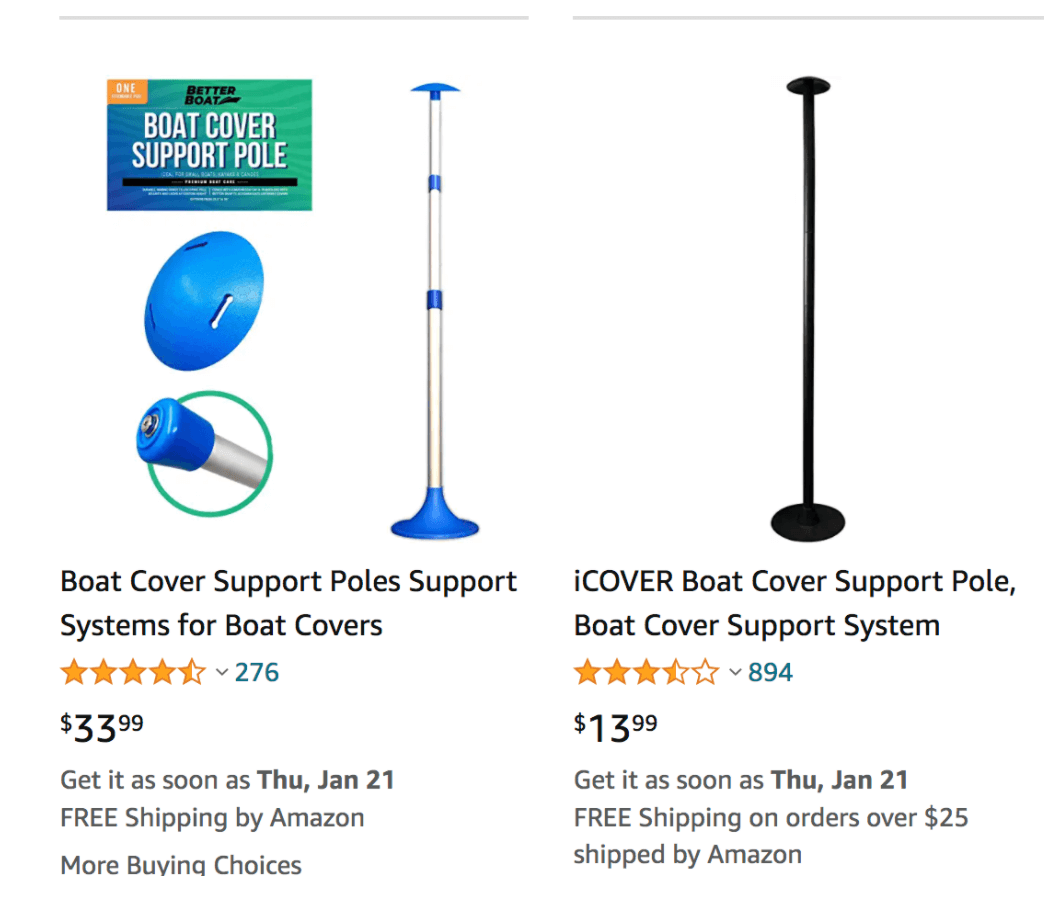
As you can see, the support pole on the left is priced almost two and a half times higher than the one on the right. According to Jungle Scout Extension data, it also sells more, even at that higher price.
Why the difference? Upon further inspection, the support pole on the right is made from a thin plastic material that, according to the many angry reviews, snaps easily. On the other hand, the blue support pole on the left appears to have solved that problem—it’s made out of stronger aluminum. So while Righty is the cheaper option up front, buying it will likely cost the customer more money in the long run, when they inevitably purchase a sturdier replacement—like Lefty.
In this case, the seller of the blue support pole can justify the higher price point with the material quality differential. Without ditching the flimsy materials, there’s no way customers would purchase their product at a higher price.
Moral of the story: you can’t sell the same old product and expect a higher sale price.
4. A/B test different prices
A great way to figure out which price your product performs better at is to run a split test, or A/B test. A/B price testing is simple: list your product at two different prices for a set amount of time, then compare its performance. In this way, running a split test allows you to make data-driven decisions on pricing instead of just guessing.
For example, let’s say you have a product priced at $24.99, but you want to know if it’ll still sell well at a higher price point. For two weeks, track your product’s sales performance at $24.99. Then for another two weeks, list it at $26.95. At the end of those four weeks, take stock of which period of time saw the highest sales. If you sold more at the higher price, keep it!
Learn how to A/B test your listings with our step-by-step guide.
5. Price products above Amazon’s free shipping minimum
Amazon Prime members receive free shipping on all Prime-eligible products—but what about buyers who are not Prime members?
Non-Prime members in the US pay for shipping on all orders below $25. That shipping cost can add an additional $5-10 to the customer’s order, which could deter purchasing. If you price your products above that $25 threshold, you may experience a higher conversion rate among non-Prime customers.
Let’s use the same product examples as before to see how this works:

The above image shows how the two different boat cover support poles appear within Amazon search results. The product on the left is priced at $33.99 and the one on the right is priced at $13.99. Below the listed price, you’ll see that the shipping options differ. The $33.99 product is eligible for “FREE Shipping by Amazon” because it is priced above Amazon’s $25 minimum. The other product will only ship for free if it’s part of an order “over $25 shipped by Amazon.”
So if I ordered the product on the right, I’d either have to pay for shipping or tack on another item costing at least eleven bucks to qualify for free shipping, whereas shipping the product on the left is already free.
6. Use “charm pricing”
Charm pricing, also known as psychological pricing, is the practice of purposely pricing products in a way that influences customers’ purchase behavior.
For instance, try pricing your product at $19.99 vs. $20. At $19.99, the product seems like a better deal, even though it’s literally one cent cheaper.
If you’re selling a product that’s more of an “impulse purchase,” like a novelty item, using this pricing strategy may help increase your conversions as the customer may feel like they’re getting some kind of deal.
Here’s an example of what I’d call an “impulse purchase.” This waffle maker comes in a rainbow of colors, is highly rated, and is quite affordable. But it’s tiny—well outside conventional notions of waffle size—and is therefore more of a novelty than a staple kitchen gadget.
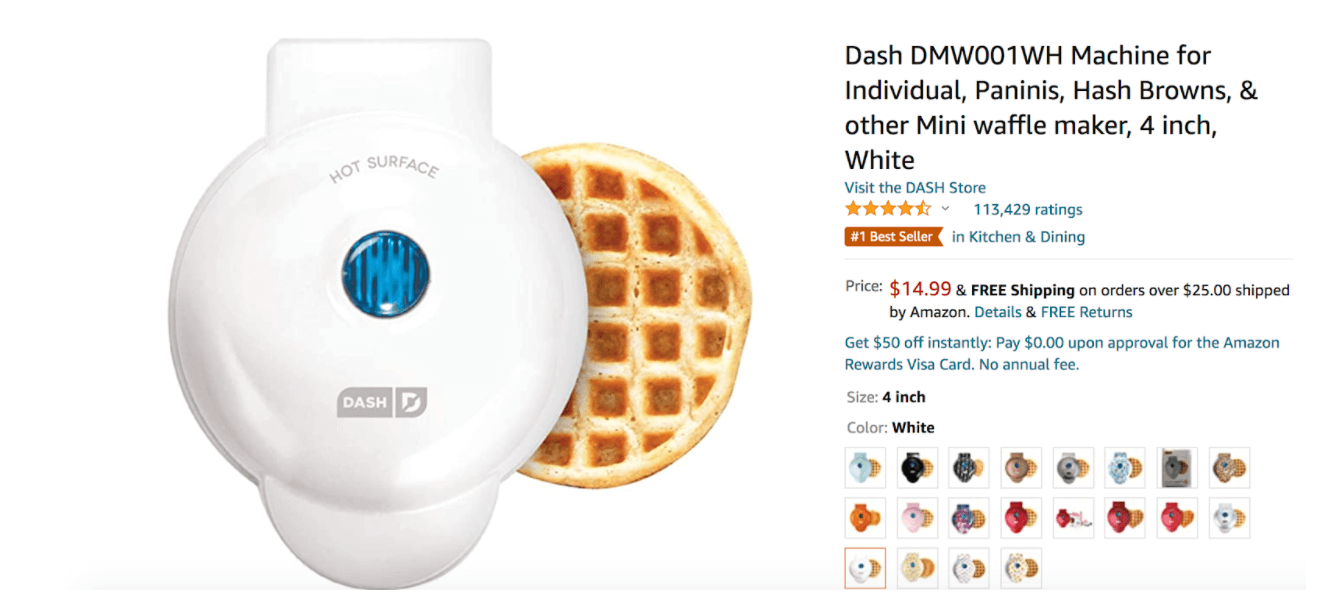
You can use A/B testing to see if charm pricing works for your product. Try prices ending in .99, .95, or .90 and see if they perform better than a round number.
By contrast, if you’ve listed an expensive or luxurious product, you could try going for prestige pricing. Luxury products tend to sell at prices ending in .00—think Apple gadgets and designer handbags. A round-number price may work better for your product, so try A/B testing prices ending in zeroes.
7. Set a Business Price
If you didn’t already know, Amazon allows businesses to register for a business buyer account. This allows commercial customers to purchase products for their business tax-free, as well as reap other benefits such as bulk discounts.
As a seller, you can set business prices for your products that only Amazon Business-registered buyers will see. You can offer discounts and bulk prices, encouraging large orders from commercial clients.
Here’s what an Amazon Business buyer sees when you set a business price.
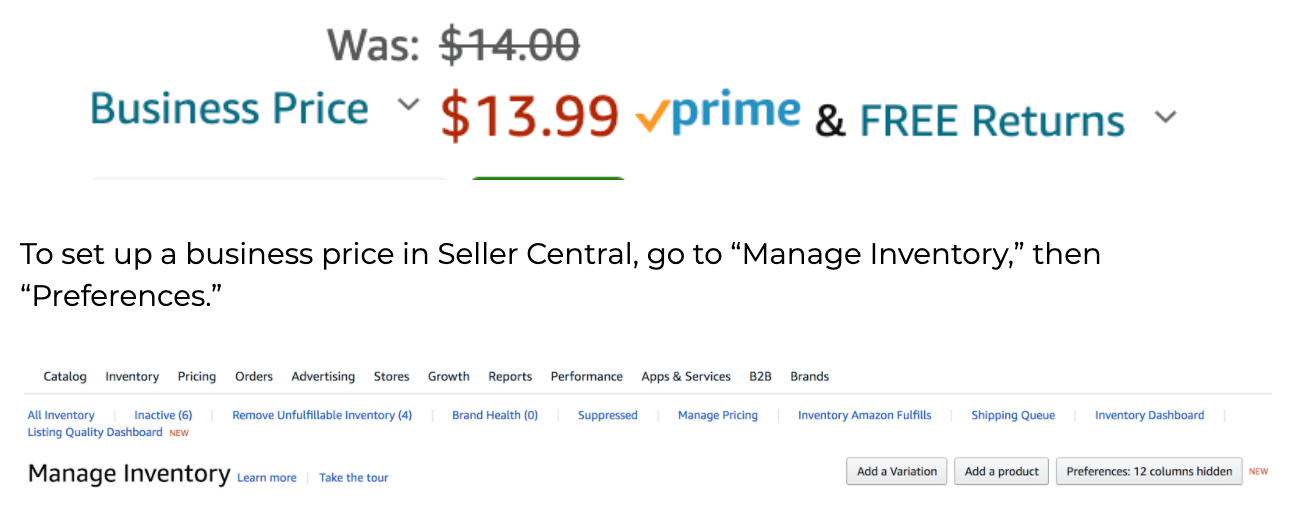
To set up a business price in Seller Central, go to “Manage Inventory,” then “Preferences.
Make sure “Business Price” is checked.

Now, you should see the option to set a business price and quantity discount in your “Manage Inventory” section.
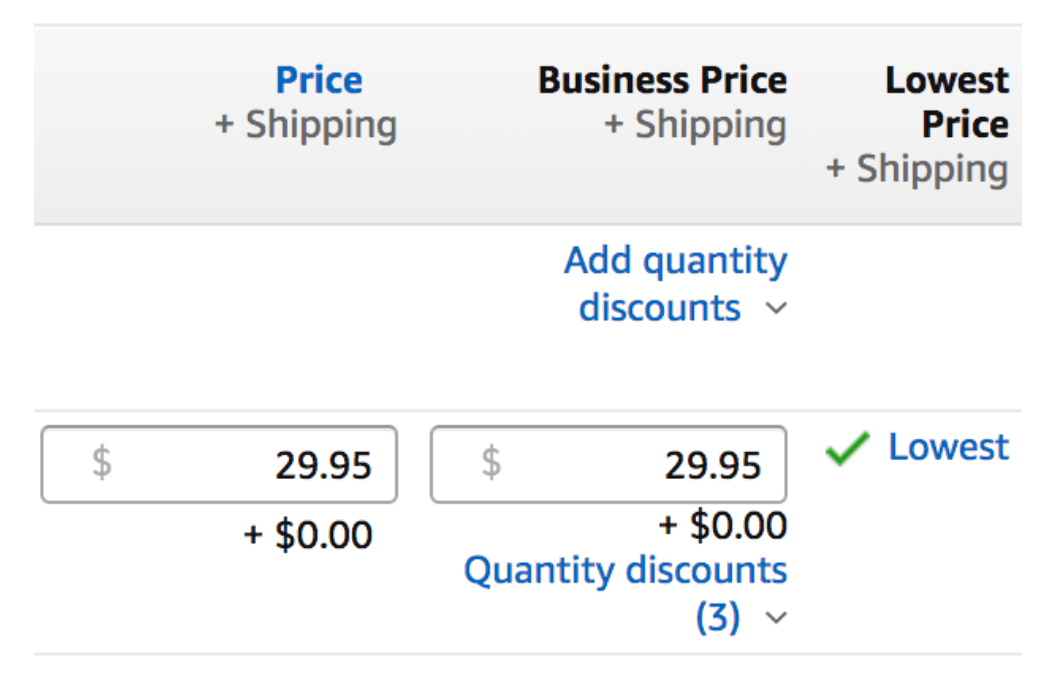
Set your desired price and quantity, and you’re good to go.
8. Provide discounts using coupons
Adding a coupon to a new Amazon listing is a great way to get some initial sales rolling. Within keyword search results, Amazon will display a bright, eye-catching coupon offer underneath your price to entice customers. This can increase your listing’s click-through rate and conversions.
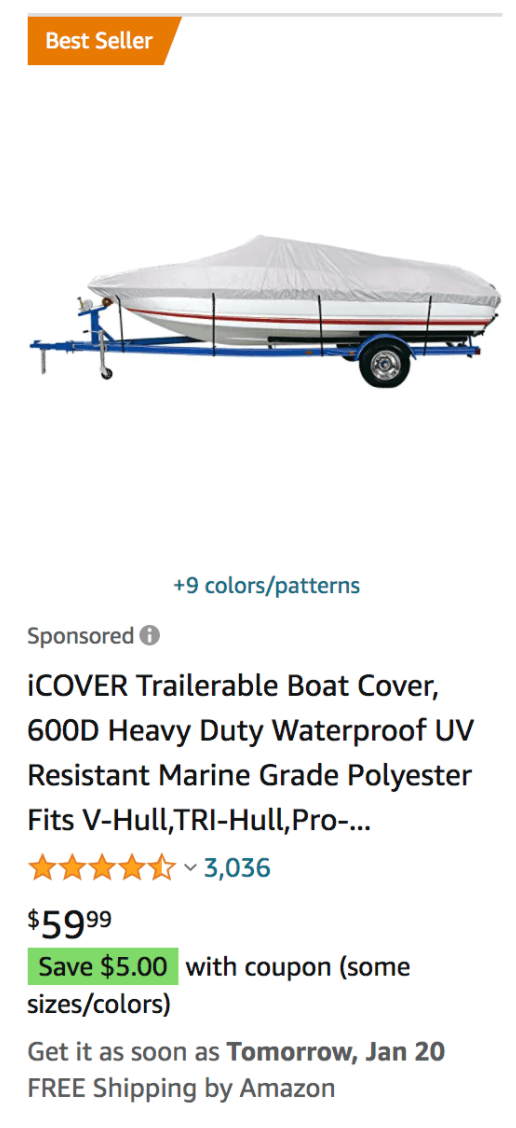
A great way to use coupons on Amazon is to actually raise your price slightly, then add the coupon to your listing. That way, customers still feel like they’re getting a great deal without discounting your product too much. Psychologically, adding a discount via coupon can be more effective than just lowering your price without a coupon.
It’s easy to set up a coupon through Seller Central. Go to “Advertising,” then “Coupons.” Click “Create a new coupon” and complete the steps that follow. You’ll be asked to enter the product you want to discount, choose your discount type (Money Off or Percentage Off), and a time frame to run the promotional pricing.

Optimize your pricing strategy sooner rather than later
Are you missing out on higher profits? Put your pricing strategy to the test using the techniques listed above to find out! Amazon is an extremely competitive marketplace, and what works for your competitors may not work for you. Be thorough with price testing and you’ll eventually land on a price point that allows your product to make consistent sales.
Do you have any other questions or tips regarding pricing strategies on Amazon? Let us know in the comments below!
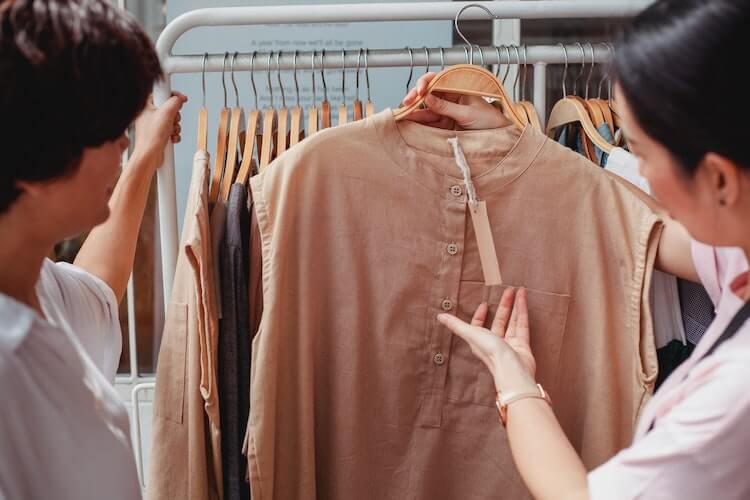

 6 Comments
6 Comments
6 comments on “2021 Amazon Seller Pricing Strategy – How to Price a Product”
Hello, I would like to know the different between standard price and sale price. I just star with my amazon account and when I created the listing I had to put this two price but I do not know the difference. Can you please help me with that! Thank you so much!
Mariana
Hi Mariana,
Just put the standard price in. Amazon has been getting rid of the “sale price” shown on an Amazon product detail page.
I sell used books on Amazon, most in the the range of $5–$20. So, my “profit” margin is often $3–$4 per book after Amazon fees and actual postage costs. I notice that some similar sellers are offering “free shipping”, or lower, or higher shipping fees than the standard Amazon $3.99. My question is, is it more advantageous (in terms of Amazon fees, ignoring psychological or strategy considerations) to sell a book for $10.01 with standard $3.99 shipping, or $14 with free shipping? or $4 with $10 shipping, etc?
Hi John,
My conversions have always been higher when offering free shipping on books versus on added shipping costs. With that said, customers will usually buy from the seller with the lowest overall cost, assuming the condition of the book is the same.
Kym,
you have mentioned so many tools including RepricerExpress , Splitly, profit peak, etc. for a beginner, which tool is better suited for a beginner?
we may not be able to afford so many tools. if we only afford for one tool, which one is best?
thank you,
George
Hey George,
It depends on what kind of seller you are 🙂
If you are selling private label then Splitly is your best option for testing your product pricing. Profit Peak is actually a feature on Splitly which allows you to automate your pricing.
RepricerExpress (who wrote this article) specialise in repricing for sellers who are competing for the Buy Box. This can include arbitrage and wholesale sellers!
Hope that helps!
Kym